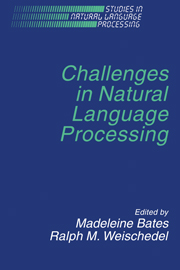Book contents
- Frontmatter
- Contents
- Preface
- Symposium participants
- Part I Challenging problems
- Part II Building a lexicon
- Part III Semantics and knowledge representation
- Part IV Discourse
- 7 Getting and keeping the center of attention
- 8 Surface structure, intonation, and discourse meaning
- Part V Spoken language systems
- Part VI Conclusion
- Author index
- Subject index
8 - Surface structure, intonation, and discourse meaning
Published online by Cambridge University Press: 05 March 2010
- Frontmatter
- Contents
- Preface
- Symposium participants
- Part I Challenging problems
- Part II Building a lexicon
- Part III Semantics and knowledge representation
- Part IV Discourse
- 7 Getting and keeping the center of attention
- 8 Surface structure, intonation, and discourse meaning
- Part V Spoken language systems
- Part VI Conclusion
- Author index
- Subject index
Summary
Introduction
The structural units of phrasal intonation are frequently orthogonal to the syntactic constituent boundaries that are recognized by traditional grammar and embodied in most current theories of syntax. As a result, much recent work on the relation of intonation to discourse context and information structure has either eschewed syntax entirely (cf. Bolinger, 1972; Cutler and Isard, 1980; Gussenhoven, 1983; Brown and Yule, 1983), or has supplemented traditional syntax with entirely nonsyntactic string-related principles (cf. Cooper and Paccia-Cooper, 1980). Recently, Selkirk (1984) and others have postulated an autonomous level of “intonational structure” for spoken language, distinct from syntactic structure. Structures at this level are plausibly claimed to be related to discourse-related notions, such as “focus”. However, the involvement of two apparently uncoupled levels of structure in Natural Language grammar appears to complicate the path from speech to interpretation unreasonably, and thereby to threaten the feasibility of computational speech recognition and speech synthesis.
In Steedman (1991a), I argue that the notion of intonational structure formalized by Pierrehumbert, Selkirk, and others, can be subsumed under a rather different notion of syntactic surface structure, which emerges from the “Combinatory Categorial” theory of grammar (Steedman, 1987, 1990). This theory engenders surface structure constituents corresponding directly to phonological phrase structure. Moreover, the grammar assigns to these constituents interpretations that directly correspond to what is here called “information structure” – that is, the aspects of discourse-meaning that have variously been termed “topic” and “comment”, “theme” and “rheme”, “given” and “new” information, and/or “presupposition” and “focus”.
- Type
- Chapter
- Information
- Challenges in Natural Language Processing , pp. 228 - 254Publisher: Cambridge University PressPrint publication year: 1993



